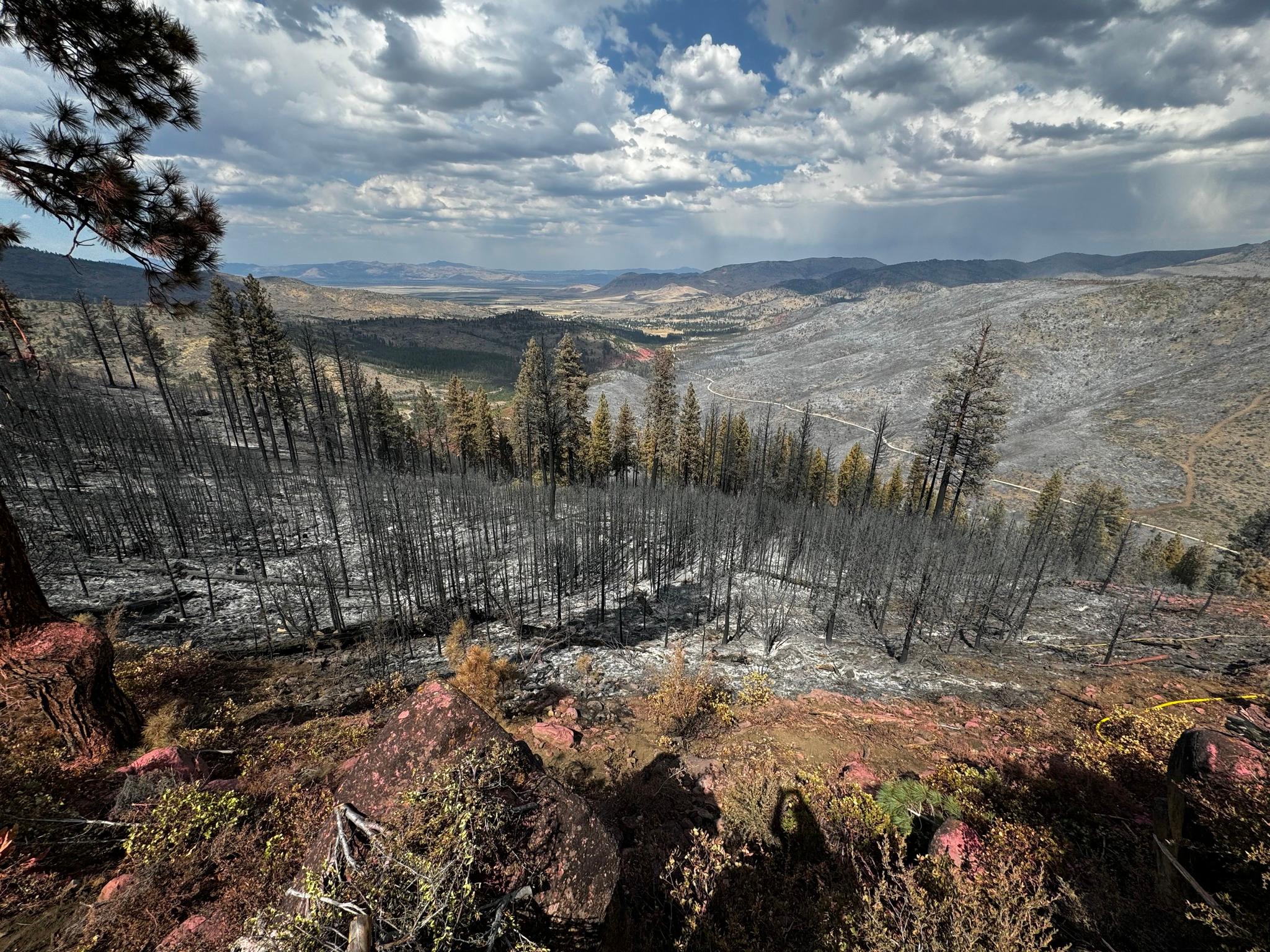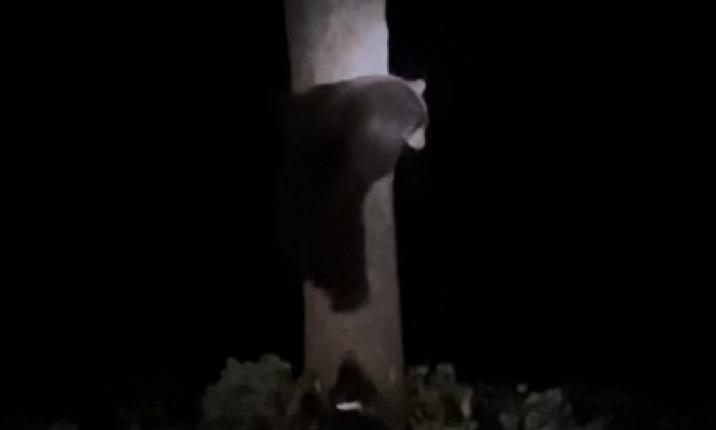Sierra City Firewise Forum Highlights Insurance Crisis
September 19, 2024

Damage caused by the Bear Fire near Sierra Brooks. Photo provided by Tahoe National Forest.
SIERRA CITY — The recent Bear Fire which threatened Sierra Brooks illustrates that fires can happen anytime, anywhere, and spread rapidly. On Sunday, Firewise Sierra City held a community event at the Sierra City Community Hall to discuss the importance of and strategies for keeping our communities safe and Firewise certified. The event put a heavy emphasis on the insurance crisis facing our local mountain communities, with nearly 60 residents showing up to share their concerns.
The Firewise Program (sponsored by the National Fire Protection Agency or “NFPA”) provides resources to help homeowners learn how to increase the fire resistance of their homes and properties. Firewise communities raise awareness, organize at the community level, and take action to create fire-adapted communities. The importance of being designated as a Firewise community was made very clear on Sunday. Many insurers have already pulled out of California or are refusing to renew current policies due to the increased risk of wildfires, leaving the California FAIR Plan as the only option for securing insurance. The FAIR Plan, first established in 1968, has grown to become the primary wildfire insurer for many Californians living in high-risk fire areas, providing last-resort insurance access for homeowners unable to obtain it from traditional insurance carriers.
Of the nearly 60 homeowners and business owners in attendance, only five homeowners still have private insurance. Many expressed frustration that their insurance companies have simply dropped them, leaving the FAIR Plan as their only option. Reliance on the FAIR Plan has ballooned in recent years, with experts stating that a single major fire incident could make the fund insolvent. Additionally, with the high demand for the FAIR Plan, there is a backlog of applicants. A FAIR Plan policy typically costs more and offers less coverage than traditional property insurance. Californians can supplement a FAIR Plan policy with a difference in conditions (DIC) policy to obtain additional coverage, but these policies are extremely difficult to obtain. Speaking with Rebecca Mooers, a local Sierra City resident and realtor for REMAX Gold in Nevada and Sierra counties, the FAIR Plan accounts for almost all new policies she has seen issued in the two counties in recent years.
Some homeowners and business owners who say they cannot afford the steep increases have simply decided to forego having any insurance and are rolling the dice that there isn’t a fire. However, banks require insurance for a mortgage, so that is not an option for most. Many homeowners in Sierra County said that insurance companies sent inspectors to take photos and inspect their homes for fire safety, requiring them to clear trees and forest debris or risk having their policies canceled. Some companies even use Google Earth to look at homes remotely. Even if a homeowner has created defensible space and complied with their insurance company’s requirements, some insurers are dropping policies in areas that are not designated as Firewise safe communities. During the meeting, Sarah Kubly pointed out that according to an index insurance companies use to determine risk on a scale from 0-99 (with 99 being the greatest risk), much of Sierra County is rated at about 93.
The Rural County Representatives of California (RCRC) has taken up insurance as one of their top issues. The RCRC is an organization with forty county members that champions policies on behalf of California’s rural counties on a myriad of issues including land use, water and natural resources, housing, transportation, wildfire protection policies, and health and human services. According to Staci Heaton, Senior Policy Advocate for RCRC, the insurance crisis is hitting small forested communities the hardest. RCRC has been meeting with Ricardo Lara, California’s Insurance Commissioner, and the insurance industry associations to push for help addressing this crisis. The path forward is a bit uncertain, but a key component is catastrophic modeling for forest fires that the insurance industry is demanding in order to issue new policies in California. Florida is the only state that currently allows catastrophic modeling with mixed results. California desperately wants big insurance companies like Allstate and Farmers to return to the state, and the insurance companies say that modeling will allow them to set accurate premiums. Consumer advocates worry that this will only increase rates in “distressed” or fire-prone areas.
On Tuesday, September 17, Insurance Commissioner Lara and Cal Poly Humboldt announced they would form a strategy group to undertake the nation’s first “public wildfire catastrophe model.” The strategy group will draw from California’s research and higher education communities to make recommendations for a new, publicly accessible data source to predict future wildfire losses. This effort will support California’s goals of building safer communities and expanding access to insurance coverage. This partnership is fueled by a new regulation that Commissioner Lara is currently finalizing that will allow insurance companies to utilize forecasting to set insurance rates. The California Department of Insurance held a public hearing on the same day to take public input on the proposed catastrophe modeling and ratemaking regulation that would go into effect in December 2024. The regulation specifies that models must calculate wildfire safety benefits, such as forest-management actions by state and local fire agencies and work by public and private utilities to reduce ignition sources – something not required under current rules. As part of this new regulation, insurance companies would be required to provide insurance in “distressed communities” like Sierra County within at least 85% of the rate they insure in non-distressed counties.
Commissioner Lara also announced new regulations to address the state’s insurance crisis before the Assembly Insurance Committee. Beyond catastrophic modeling, that plan includes reducing reliance on the FAIR Plan, increasing insurance availability, and pledging to create more transparency and accuracy in rate making. Using computer models and software algorithms to set premiums is prohibited under Proposition 103, the Insurance Reduction and Reform Act passed by voters in 1988.
The major takeaway from Sunday’s community roundtable is that prevention and preparation are the best ways to mitigate wildfires. Have a go bag ready with your most important valuables, have a plan on where to go outside of Sierra County (which may not have resources available to open up a shelter), and make your home fire-safe. Also important is knowing your local evacuation zone. The Sierra County Sheriff’s Office strongly encourages enrolling in alert programs and apps such as EVERBRIDGE, Genasys, and Watch Duty to stay informed and updated on the latest fire activities and evacuations. Knowing where to access the internet backed up by a battery or generator can be crucial as the power often goes out when a fire approaches.
To learn more about how to be part of a Firewise community, volunteer, and be better prepared for wildfires, go to https://www.firesafesierracounty.org/firewise-communities.
Featured Articles

Two Plead Guilty to Poaching and Animal Cruelty Charges →
December 30, 2025
Two men face penalties for illegal hunting activities in Sierra County.
Fish and Wildlife Plans to Collar More Deer, Elk, and Wolves →
December 30, 2025
DWR Conducts First Snow Survey of the 2025-2026 Season →
December 31, 2025
Storms Bring Heavy Rainfall and Local Disruptions →
December 22, 2025
Sierra Hardware Plans Extensive Repairs After Flood Damage →
December 8, 2025
